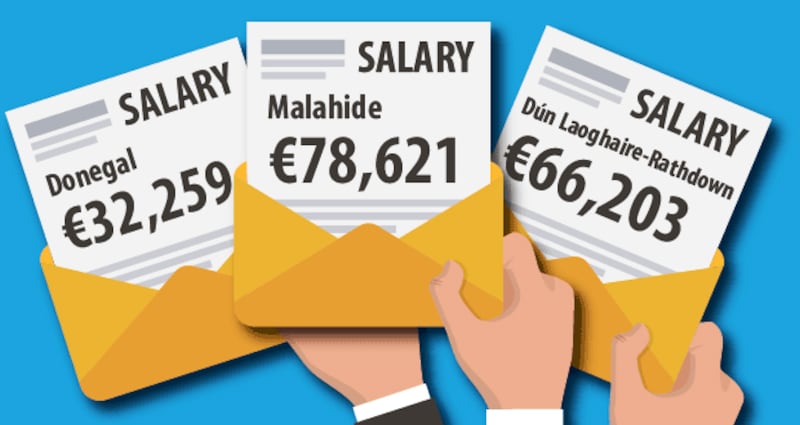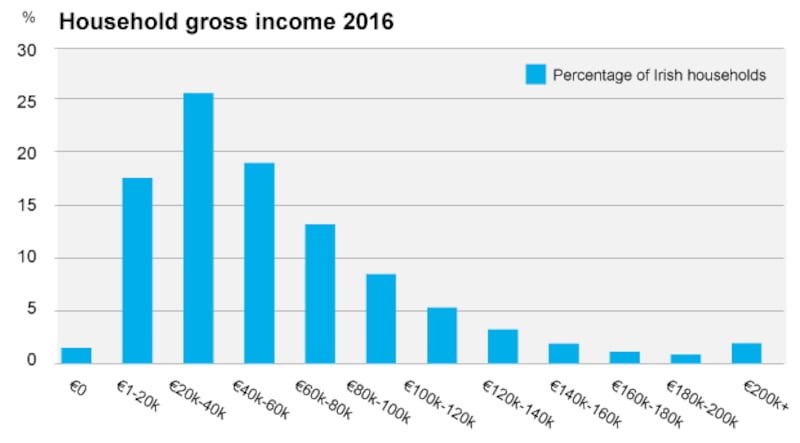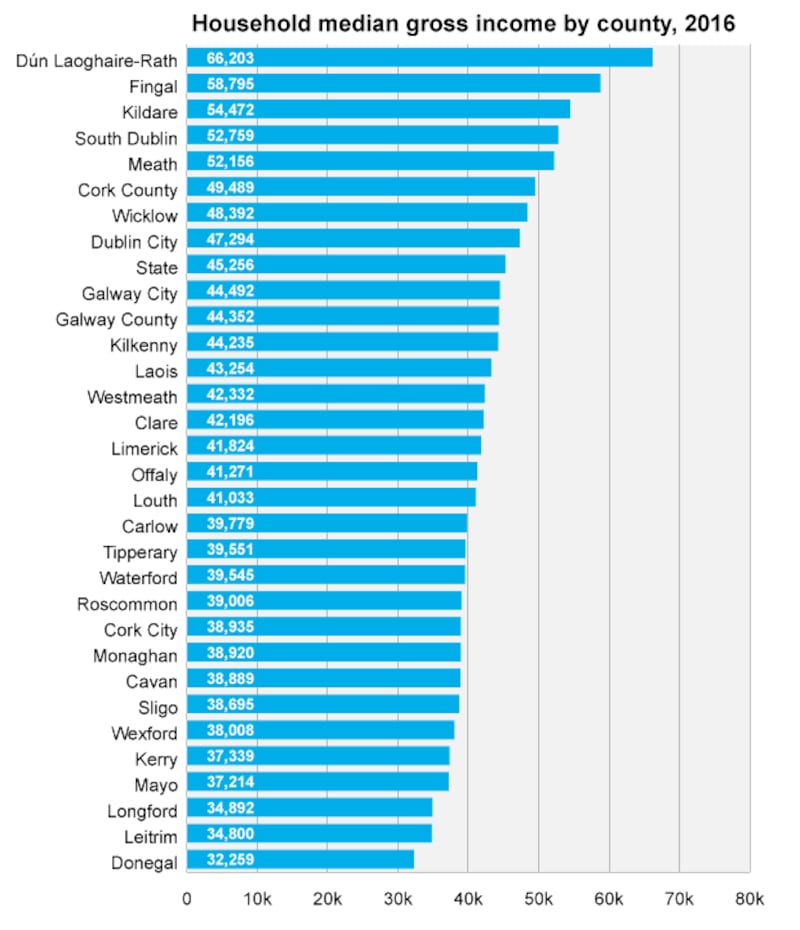How much do people earn in different occupations and parts of the country? And what does this mean for policy?
Recent figures from the Central Statistics Office (CSO) have given a rare glimpse into the breakdown of who earns what and where – a treasure trove of information on the winners and losers in the earnings stakes. This is vital information not only because we all like to know what everyone earns, but also for policy.
For example, it shows some of the areas most exposed to Brexit already have relatively low earnings. And it shows that, when a significant minority are doing very nicely, more than one in four households are reliant on social welfare.

1. The overview – most earning under €60,000
The figures cover household earnings and so are different from the usual CSO earnings figures covering individuals. They involve data from Revenue and two government departments, as well as the CSO, so this is new territory.
It shows average gross (before tax) household income of €45,256 in 2016 – earnings growth since has probably pushed this above €50,000. For comparison, the average income for employment or self-employment for an individual was €26,000 in the same year – remember this covers both full and part-time employees.
Interestingly, two thirds of Irish households had a gross income of less than €60,000 – and just 14.1 per cent had incomes of over €100,000. A lot of households are living on modest incomes – just over one quarter earn between €20,000 and €40,000 and just under 18 per cent earn €20,000 or less.
At the other end of the spectrum, just over 14 per cent of households – around one in seven – earn over €100,000. Given the number of dual income couples, this might have been anticipated to be a bit higher.
Looking at the higher-earner breakdown, 8.4 per cent of households earned between €100,000 and €140,000, 3.8 per cent earned between €140,000 and €200,000 and 1.9 per cent earned over €200,000.

2. Big regional variations
There is – not surprisingly – a big regional variation. The new data compiles this at the level of households – as opposed to just individual earners – and so gives an important picture.
Looking at the local authority area breakdown, households in Dún Laoghaire-Rathdown in south Dublin had the highest average (median) income of €66,203, followed by Fingal in north Dublin at €58,795 and Kildare at €54,472. At the other end of the spectrum is Donegal (€32,259), Leitrim (€34,800) and Longford (€34,892). So the household income of the poorest county is just over half that of the richest.
When we dig a bit, we see that Dún Laoghaire-Rathdown had the lowest proportion of households – less than 6 per cent – reliant on social welfare for most (50 per cent plus) of their income. In contrast, in Longford and Donegal around one in five were reliant on welfare for over half of gross income.
Younger counties – such as Fingal (just 6.9 per cent reliant on the State pension) – also tended to be richer than the likes of Donegal and Leitrim, where not far off one in five depended on the State pension.
Separate figures covering towns with a population of 10,000 and over (excluding cities and immediate suburbs) also show big regional income variations. Malahide in north Dublin had the highest median income of all 41 towns at €78,621, with Celbridge second at €64,877 and Maynooth third at €64,529.
Nine of the 10 highest were in Leinster, with Carrigaline highest in Munster at €59,353. Lowest were Longford town (€29,224), Enniscorthy (€31,049) and Ballina (€32,779).
Regional variations are confirmed by looking at earnings for individuals at work – as opposed to households. Dublin city had the highest earned income per person working at just under €40,000, followed by Dún Laoghaire-Rathdown at €37,117 and Cork city (€34,317).
The lowest individual earnings were in Donegal (€24,626), Monaghan (€24,903) and Leitrim ( €25,962). These figures cover full and part-time employees.

3. The rise of the two-income couple
You have to pick through the figures a bit, but it is clear that in the majority of couples both are now in employment and that many have significant outgoings from mortgages and families.
First we see that households who were owner-occupiers with mortgages tend to have the highest median incomes, at over €68,000. This is partly due to their stage in life – people with mortgages are usually in their working years and often two incomes are required to pay all the bills.
Owner-occupiers who owned their house outright had an average income of €37,733 – this category includes most pensioners.
Four out of 10 households have two or more people earning an income. Or broken down another way, in more than six out of 10 couples, both are earning an income.
The gender pay gap is real, with men earning more than women in two-income couples in 46 per cent of cases, both earning roughly the same in around one third of cases and women earning more in the remaining couples – less than one in five of the total. Note here that the figures are not adjusted for hours worked.
A further indication of necessity driving income is that families with three children or more are the highest earners, at almost €69,000.
4. The policy lessons
The CSO points out that the data can have important policy inputs. The latest figures point to a number of issues:
– The areas of the country which previous research has shown are most exposed to a hard Brexit are also generally those with lower incomes. Sectors with a high reliance on agriculture, food production and on SMEs are most exposed, including the Border counties and rural Ireland in general.
– The average household income in the four Dublin local authorities is €57,000, while the average in the Border countries is less than €37,000. Not surprisingly Border and other rural areas are much more exposed to agriculture, often relying on it for 10-15 per cent of income, compared to well under 1 per cent in city areas.
– The male/female earnings divide is noticeable and there is some new data here. Looked at by profession, for example, male doctors earn an average of €100,000 versus €75,000 for their female colleagues.
For financial managers and directors, males earn €94,500 versus less than €77,000 for females. The gaps are striking, though a full comparison would also look at hours worked and the seniority of the jobs held.
– There are indications that longer-distance commuting is a big factor of Irish life. Household incomes in Kildare (€54,472), Meath (€52,156) and Wicklow (€48,392), are well above the national average – indicating the likelihood that many travel to Dublin and its environs for work. (There are exceptions: for example, Intel has a giant plant in Leixlip in Kildare).
Interestingly, the figures show that those who commute for longer earn more. The average income was €32,000 for those who commuted less than 30 minutes, compared to just under €41,500 for those who travelled more than 30 minutes – and almost €44,000 for people commuting into Dublin.
If you live in Wicklow, Meath and Kildare, your household income will be €13,000-€15,000 greater if you commute for more than 30 minutes. This commuting trend has huge implications for lifestyles and shows the challenge for Government in achieving its goal of creating housing closer to where people work, served by public transport.
– There remain a lot of households on relatively low incomes and reliant on social welfare or State pensions. Social welfare payments to people of working age made up more than half of the income in 13.7 per cent of households, while the State pension formed the majority of income in 12.9 per cent.
So in more than one quarter of households, social welfare made up more than half of household income in Ireland in 2016.













